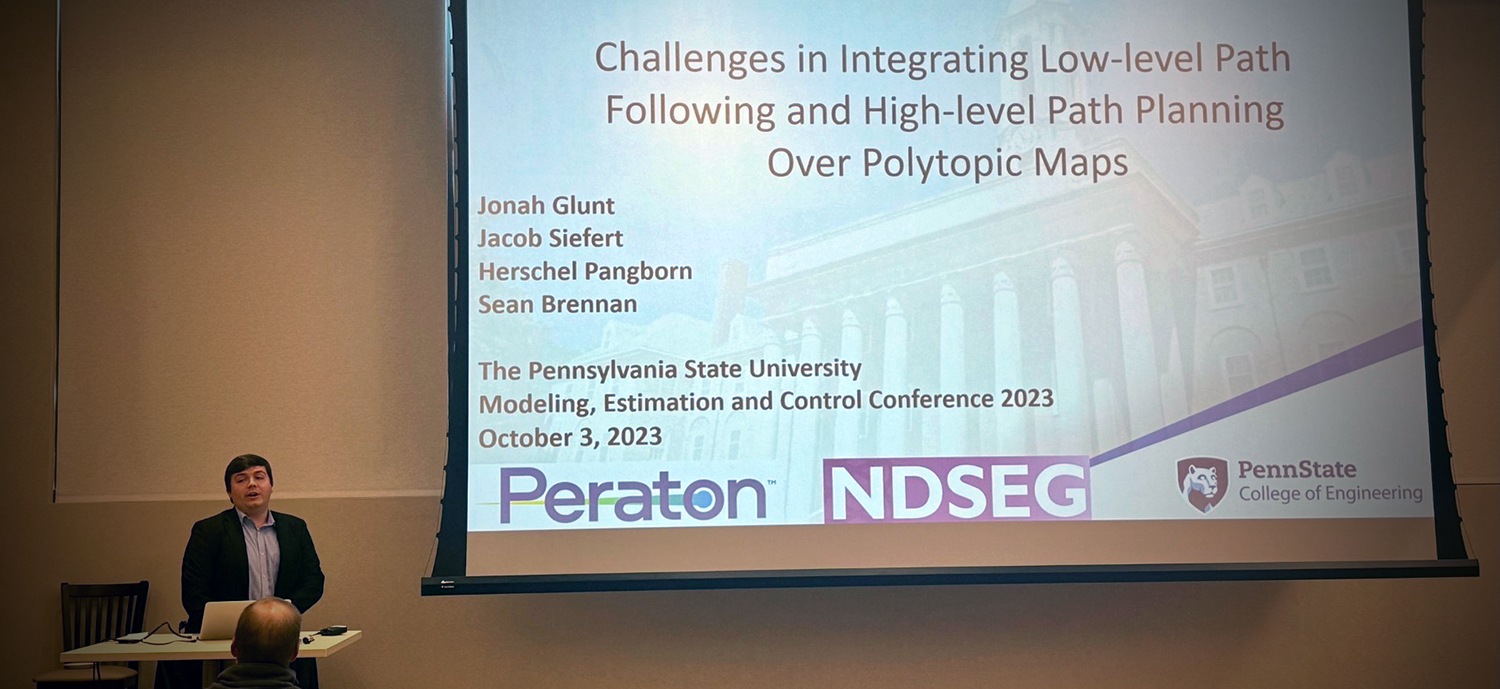The Challenge The Solution The Impact
Peraton has partnered with various universities across the nation to support customers of mutual interest, increase STEM accessibility by sponsoring students, research, and hiring in mission critical areas. The company joined PSU’s Engineering/EECS Affiliates Program in July 2022, facilitated by the Penn State College of Engineering Office of Corporate and Industry Engagement, to help further this effort. Since the start of this partnership, Peraton has hired 28 interns and college graduates from Penn State to support numerous missions of consequence for the company’s customer base.
One of the company’s summer 2023 interns, Jonah Glunt, is among several PhD candidates working on a Peraton-sponsored research project under Dr. Herschel Pangborn, Dr. Sean Brennan, and Dr. Puneet Singla at Penn State. Their work is titled “Integrating Path Planning, Following, and Online Learning in Multi-Agent Competitive Games.” Through his internship at Peraton, Jonah helped to transition the university’s path planning research into the Joint Operating System (JOS) IRAD program.

Jonah Blunt, former Peraton intern and PhD candidate at PSU, presenting at the 2023 Modeling, Estimation, and Control Conference in Lake Tahoe, NV.
The Challenge
Mission planning and rehearsal is often challenged by the complexity, dynamics, and non-cooperativeness of operational environments. Peraton’s customers have a need to augment planners with automated tools that identify near-optimal solutions in these environments to avoid collision or detection and maximize the likelihood of success.
The Solution
Peraton is working collaboratively with Penn State to address these customer needs by leveraging their path planning research. The team is investigating a hierarchical framework for vehicle autonomy that integrates a highly flexible path planner, a predictive path following controller, and an efficient traversal cost estimator. This is creating a value stream that Peraton is building into a mature, cross-cutting product.
Path planning in complex, dynamic and competitive environments is an innovative technology solution with multiple applications across a broad range of Peraton’s missions and domains. For example, it is an integral component to pre-mission ingress/egress planning and rehearsal, robotic obstacle avoidance in swarms, and routing in cyber networks.
The Impact
Peraton and Penn State’s deep relationship interconnected joint efforts in the areas of workforce development, recruiting, research, and partnerships. The research projects helped advance technology innovations for Penn State and Peraton while also developing students’ skillsets in AI and autonomous systems. The Penn State research team presented a paper titled “Challenges in Integrating Low-level Path Following and High-level Path Planning Over Polytopic Maps” as part of an invited session on Unmanned Aerial Vehicle Mission Planning and Controls at the 2023 Modeling, Estimation and Control Conference. The paper is a testament of how the university-company partnership can generate a hierarchical framework for vehicle autonomy that integrates a highly flexible path planner, a predictive path following controller, and an efficient traversal cost estimator.
“To innovate for the future, you have to look beyond the status quo and the way things have always been done,” said Mark Adams, vice president, Technology and Engineering (T&E), Peraton. “Through our partnership with Penn State, we have leveraged the spirit of innovation to advance critical mission planning algorithms, which are then applied to solve our customers’ most difficult problems. Success is shown most prominently when we are able to trace the solutions our employees and interns develop back to the business and to our customer missions.”
The cross-pollination between Penn State and Peraton connects the pathways between academia and industry while fueling the next generation of leaders in the workforce. Student intern research in autonomy, when done well, is impactful and receives a level of visibility that can be a catalyst to a full-time position upon graduation.
“In terms of workforce development and recruiting, AI and autonomy are specialized skillsets that aren’t taught broadly in the classroom. The Penn State research we support includes master’s and PhD level students who are gaining invaluable experience by working on solutions they can apply to industry. Jonah is a prime example of how we can leverage internship experiences last summer for current and future technology transfers,” said Greg Caufman, senior director, T&E, Peraton. “We will continue to build on the connections and solutions we’re creating at Penn State to ensure the right talent is available to grow our business in these areas, which ultimately strengthens our ability to execute on our customers’ critical missions.”
Based on the experience he gained from the Peraton sponsored research and internship, Jonah was recently awarded a National Defense Science and Engineering Graduate Fellowship from the Office of Naval Research and was also an honorable mention for the National Science Foundation Graduate Research Fellowship Program.
“Preparing students for impactful careers and translating research into practical applications are two of the pillars of our mission in Penn State College of Engineering,” said Tonya L. Peeples, interim Harold and Inge Marcus Dean of Engineering at Penn State. “The College of Engineering Office of Corporate and Industry Engagement catalyzes these mission-aligned collaborations. Industry partnerships such as the one with Peraton are key to providing top-notch, hands-on experiences for students that result in meaningful employment and in bringing our research out of the lab and into the world.”
Herschel Pangborn, assistant professor of Mechanical Engineering and Aerospace Engineering at Penn State, echoed these sentiments.
“Our partnership with Peraton provides an outstanding opportunity to create new fundamental methodologies for vehicle autonomy while training the next generation of engineers and researchers,” said Pangborn. “Close interaction with industry allows us to better understand the exigent challenges facing this important field. We can then facilitate the transfer of new solutions to practice to benefit society.”
Published: Dec 7, 2023




